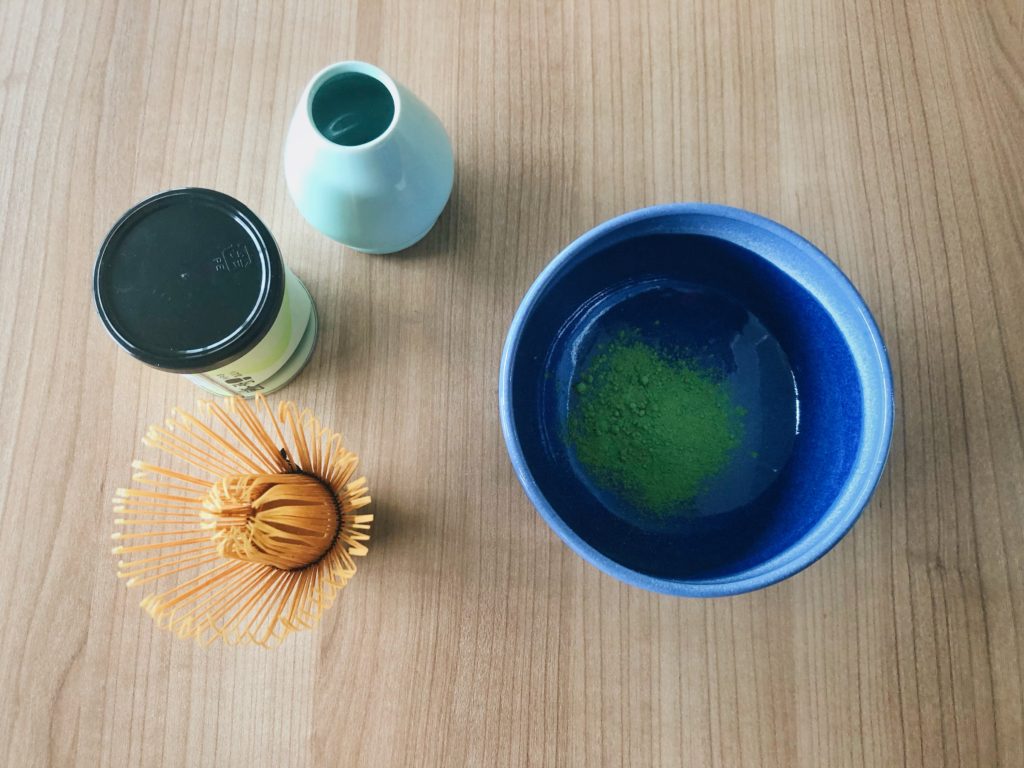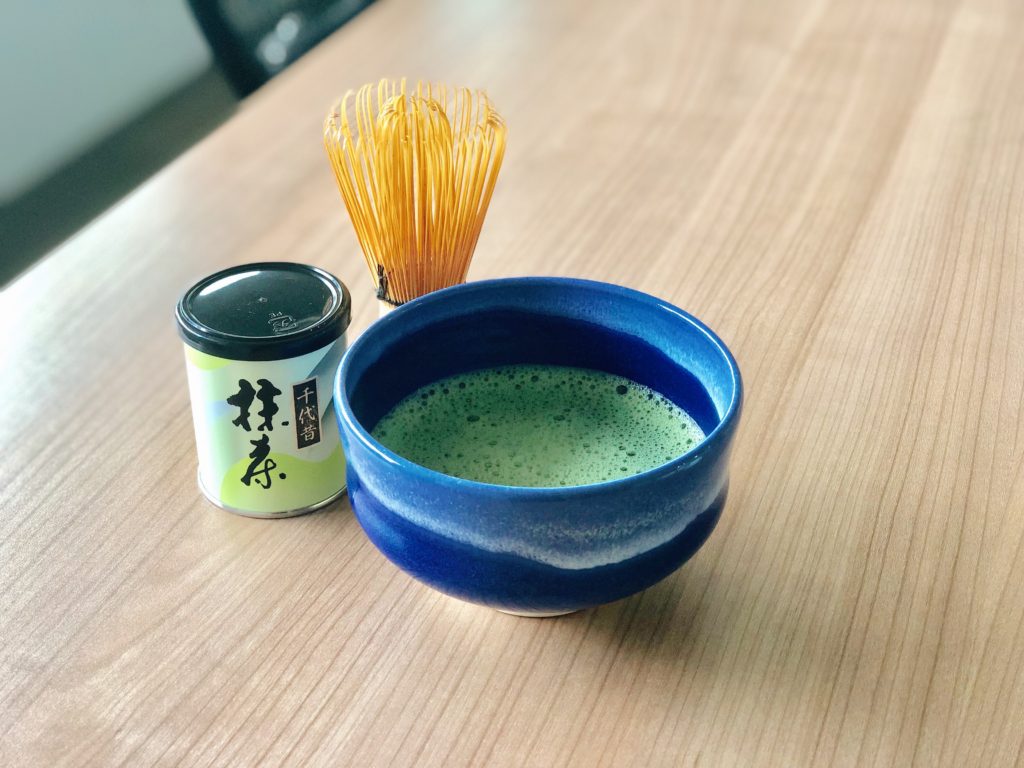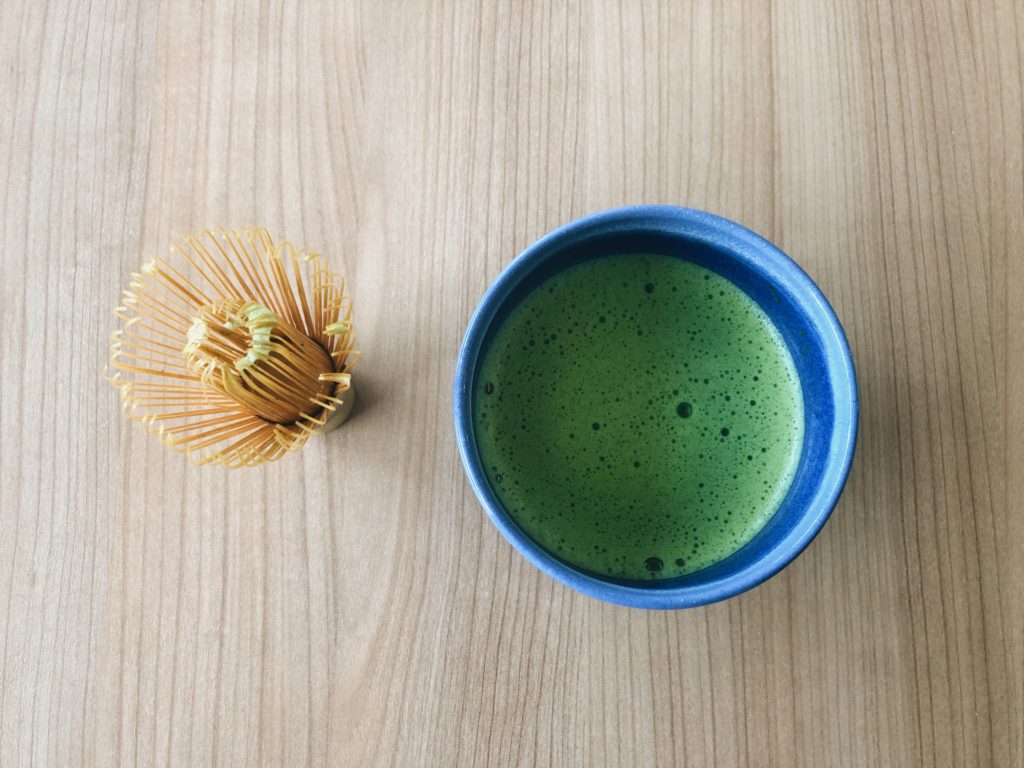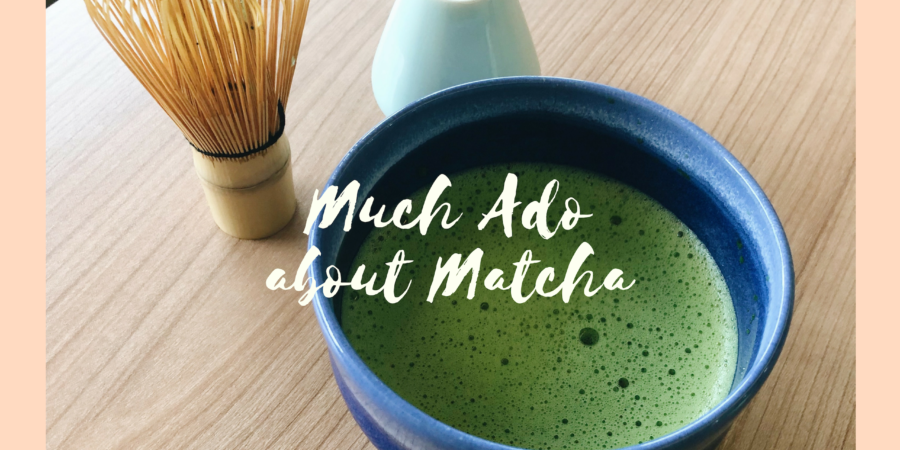Recently, my company received a few tins of matcha, so we’ve been having matcha pretty much every day. I can’t drink too much, but since we’re sharing the matcha, I’ve been able to drink a little every day and you can’t believe how happy I am about it (of course, I have to drink water or tisanes for the rest of the day but it’s so worth it). Since I’m on a matcha trend, I thought I’d do a post about what I know about matcha.
What is Matcha
At its core, matcha is dried tea that has been ground into a powder using a stone grinder. Matcha is made from 碾茶 (tencha), which according to the book I’m reading means「挽臼で粉砕する茶」, which in English is “tea that is ground using a mill”. As with gyokuro, tencha is shaded before being plucked. Unlike the other teas, tencha is the only tea that is not rolled before being dried.
After tencha is made, it’s aged for a while in a storage area (the book does not elaborate on how long and under what conditions[1]), and then ground in small amounts in a stone mill. An online reference doesn’t talk about storage, but it does say that different tencha can be blended to taste before being ground and sieved. The stone mill is typically 30cm to 40cm in diameter [2].
History of Matcha
The earliest mention of tea in Japanese history is in the 日本後紀 (nihonkoki), when the emperor Saga visited the Honjyaku temple in Shiga and received a gift of tea from the monk Eichu (永忠). Eichu left Japan for Tang dynasty China, and spent more than 30 years there, learning various things including tea culture. Tea during the Tang-dynasty was normally made into cakes for storage. When one wanted to drink tea, they would break off a piece of the cake, roast it, crush/grind it with a mortar, and then boiled (with salt, among other things) before being drunk. This type of tea was called Heicha (餅茶) and while we would think of it as a proto-matcha (since it’s ground into a powder), it did not gain popularity in Japan because it did not suit the Japanese palate.
Then in the Kamakura period, the monk Eisai (also called Yosai), travelled to Song-dynasty China and returned in 1191. Interestingly, he visited China twice and brought back tea seeds from one of his trips and planted it in Fukuoka (then Chikuzen), marking the start of tea cultivation in Japan and helping to spread the popularity of tea. At that time, 「抹茶法」(“matcha method” or “matcha way”) started to become popular. The matcha method is said to come from the Song-dynasty China via Eisai and involves using mortars or grinders known as 「碾」to grind the tea, which is then mixed into boiling water and drunk. This really is the precursor to matcha, although the powder would not be as fine as the matcha we have today.
Health Benefits of Matcha
Matcha is said to be a superfood but there are surprisingly little papers about it available on google scholar. I suspect that not everything is online because I did find references to certain papers here and there, but this is the best of what I can find about matcha’s health benefits:
A 1984 study [3] looked at the tocopherol levels of matcha, gyokuro, and sencha. Tocopherols come in four forms: alpha, beta, gamma, and delta, and they are forms of Vitamin E. The study found that matcha had 24.1 ~ 35.9 mg/100ml of alpha-tocopherol, while gyokuro had 23.9 ~ 24.0mg/100g, and sencha had 55.6 ~ 71.4mg/100g. As for beta and gamma-tocopherol, they couldn’t detect any in matcha but found small amounts of it in gyokuro and sencha. I was a bit surprised by this, given that I thought matcha would be the highest, but it is pretty close to gyokuro which is expected.
In 1992, a test of 1991 teas (gyokuro, tencha and kabuse) showed that tencha had the highest levels of amino acids and caffeine, while gyokuro had the highest levels of total nitrogen and ascorbic acid (vitamin C). Kabuse tea had the highest amount of tannins [4]. That said, I could only find an abstract (again) for this paper and they didn’t mention if they were measuring the amounts in the dry leaf or in the tea – if it were dry leaf, the results might be quite different since you basically drink the whole leaf for matcha.
Finally, the last paper I could find about matcha and health was a 2003 study on the amount of catechins in matcha compared to green tea [5]. Catechins are antioxidants which are said to have a lot of health benefits. When the researchers compared matcha to green tea, it was suggested that the concentration of epigallocatechin gallate (EGCG) available from drinking matcha is 137 times greater than the amount of EGCG available from the green tea tested. This number comes from comparing the green tea sample with 5% methanol to a matcha sample using 100% ethanol.
If anyone is studying food science and knows more about this, do let me know! I’m intrigued as to what the difference between matcha and other green teas is now – it seems like it’s higher in caffeine and catechins, but I wonder what this means (is it a significant difference?) and whether if there are any other differences in terms of health benefits.
Taste Test – What’s the difference between different grades?
If you don’t know, matcha is divided into grades! Lower grades can be as cheap as SGD 10 (or less!) for 30g while higher grades can be as much as SGD 50+ for the same 30g! In the office, we tried two different grades of ceremonial matcha and the differences were pretty obvious!

All the equipment belongs to dhcherine, who’s our matcha master
Test 1

I took this photo for IG stories so the view of the foam isn’t the best, but you can see that there are quite a few big bubbles. This is the lower grade matcha we had, and it’s pretty obvious when you look at the foam. The foam isn’t very stable either and disappeared within a few minutes.
That said, the matcha was not bitter at all. It was a bit sweet and very umami – if you think matcha is bitter, then probably the grade is quite low (or maybe it’s fake? I learnt that fake matcha[6] exists recently!)
Test 2

This is the higher grade matcha. There are still a few big bubbles but on the whole, the foam is much more even and it lasts a lot longer. I wasn’t taking an exact measurement, but we drank this pretty slowly and the foam was still there after about 20 minutes.
Taste-wise, this was very umami, even more so than the previous matcha, and surprisingly creamy. It’s super delicious and if you don’t think that umami belongs in tea, you should try some good matcha and see if it changes your mind!
Finally, if you have matcha, be sure to store it in a fridge away from garlic and other strong smelling foods. Singapore’s hot and humid climate is extremely unfriendly to matcha so even if you bought really good quality matcha, storing it wrongly can make it taste awful!
References
[1] Most of my matcha information comes from the book 日本茶のすべてわかる本, so if I don’t cite a source for a particular fact, it’s from this book.
[2] From お茶ができるまで抹茶の製造工程 仕上げ加工工程
[3] 池ケ谷賢次郎, 高柳博次, and 阿南豊正. “まっ茶, 玉露およびせん茶のトコフェロール含量.” 日本食品工業学会誌 31.7 (1984): 459-461.
[4] 後藤哲久, 堀江秀樹, and 向井俊博. “全国茶品評会入賞茶の化学成分 (第 1 報) 玉露, てん茶, かぶせ茶の全窒素, 遊離アミノ酸, タンニン, カフェイン及びアスコルビン酸.” 茶業研究報告 76 (1992): 27-32.
[5] Weiss, David J., and Christopher R. Anderton. “Determination of catechins in matcha green tea by micellar electrokinetic chromatography.” Journal of Chromatography A 1011.1-2 (2003): 173-180.
[6] About fake matcha: I learnt this from a matcha manufacturer, but apparently a lot of matcha sold overseas isn’t actually from Japan, but rather from other countries that might not make it the traditional way! So quality might be compromised, leading to more bitterness and poorer taste.

Thanks for sharing what you know about matcha and its benefits! There are so many studies on tea, with all forms of tea having real benefits when consumed as a beverage—plus a lot of potential for other medical uses. For example, one study used green tea polyphenols, which react with iron oxide nanoparticles, to increase contrast between normal and abnormal cells on an MRI image. So much fascinating research going on!
Yeah, a lot of cool research going on! The MRI one sounds fascinating – I’ll have to google for more info! Hopefully more studies will be made available soon! (:
Here’s the source for the MRI study that I used (did a blog about this back in 2015 but I imagine there are more recent studies now as well): Lisong Xiao et al., “Enhanced In Vitro and In Vivo Cellular Imaging with Green Tea Coated Water-Soluble Iron Oxide Nanocrystals,” Applied Materials and Interfaces 7(2015):6530–40.
Thank you!
I’ve been drinking matcha nearly every day for over a year now, and was also curious to learn more about the history and benefits. Most of the studies I’ve found have been in Japanese, so I recommend searching for those if you’re looking to learn more.
I agree there are a lot more studies in Japanese. Makes me wish I was still in uni because there are a lot less Japanese papers in google scholar compared to my uni library